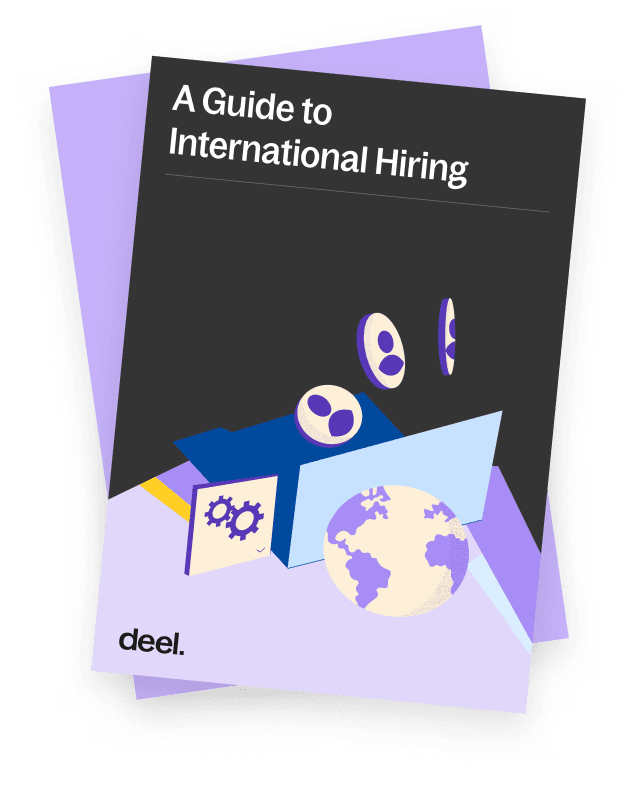Article
28 min read
How to Hire Internationally: A Guide to Global Recruitment
Global hiring
Legal & compliance

Author
Jemima Owen-Jones
Last Update
May 22, 2025

Table of Contents
Understand the compliance challenges of international recruitment
Consider hiring international independent contractors
Sell potential candidates on your remote company culture
Calculate locally competitive salaries
Expand your international recruitment channels to access a global talent pool
Implement training and systems to reduce bias during the hiring process
Use applicant tracking and onboarding technology
Simplify international hiring with Deel
Key takeaways
- Despite a 104% rise in domestic hiring, 82% of hires on Deel’s platform were for remote roles. Cross-border hiring in Latin America and the Asia Pacific grew by over 200%. This proves that the demand for international talent remains strong.
- Global hiring unlocks top talent and business growth. However, companies must navigate complex labor laws, payroll taxes, and benefits regulations to avoid misclassification risks and legal penalties.
- Deel makes global hiring simple and compliant. With localized contracts, global payroll, and legal expertise, Deel enables companies to hire international talent quickly and risk-free.
Hiring great talent is increasingly borderless. Though Deel's 2024 State of Global Hiring Report reveals a 104% surge in domestic hires, international recruiting continues to rise.
In fact, 82% of new hires made through the Deel platform are for remote positions. This underscores the growing trend of remote work and the ability to hire talent without geographical limitations.
However, expanding your hiring strategy internationally involves navigating complex challenges. You must ensure compliance with local labor laws, global payroll regulations, and varying international benefits standards.
At Deel, we recognize these complexities, having supported countless organizations in successfully establishing diverse, compliant, and thriving global teams.
Throughout this guide, you’ll learn how to manage global employment challenges expertly. Whether through establishing compliant contracts, streamlining payroll processes, evaluating contractor versus employee roles, or accurately calculating salary expectations.
Equipped with Deel's insights, comprehensive compliance knowledge, and tested expertise, you’ll confidently scale your international recruitment efforts. You’ll unlock a wider talent pool, achieve a more diverse workforce, and position your organization for significant growth.
Understand the compliance challenges of international recruitment
Searching for new hires across the globe ensures you find the best talent. But before diving into the international market, it’s essential to understand a few unique challenges:
- Entity formation to hire employees
- Compliance with local labor laws
- Global payroll and taxes
- Global benefits administration
Entity formation
The traditional way of hiring international employees legally in another country is to set up a local legal entity. However, this approach can be complex and resource-intensive.
An alternative method is using an Employer of Record (EOR) service. An EOR enables companies to:
- Legally hire employees in a foreign country without setting up their own legal entity
- Ensure compliance with local laws and labor regulations
- Handle payroll and other HR tasks
Using an EOR can be particularly beneficial when:
- Testing and expanding into global markets
- Wanting to hire full-time employees without opening a subsidiary
- Needing to ensure compliance with foreign labor laws
- Lacking resources to perform research and operations in-house
By partnering with an EOR like Deel, companies can save resources, reduce compliance risks, and streamline the onboarding process for new employees in foreign countries.
If you decide entity formation is the best course of action, Deel also provides entity setup services to streamline the process.
Discover how ShopBack hired skilled talent in countries without entities with Deel.
The primary driver for our switch to Deel was the compliance capability. We needed a platform that could quickly facilitate hiring and onboarding in markets where we didn’t have an entity,
—Carolyn Choo,
VP, People at ShopBack
See also: Pros and Cons of Hiring with an Employer of Record (EOR)
Watch the video below to learn how to hire international talent with Deel:
Compliance with local labor laws
Your international employees are subject to their home country’s labor laws, not the country where your organization operates. To be a truly global organization, you must generate contracts and conduct work that follows local labor laws, including:
- Worker classification
- Minimum wage
- Annual leave
- Termination requirements
- Tax and employment documentation
The bulleted list is just the tip of the iceberg. Each country’s labor laws are complex and constantly evolving, and non-compliance has severe consequences
Discover how Cake saved +$3k per hire in compliance costs with Deel.
Deel ensures cost-effective global hiring, providing confidence in compliance, especially in the complex landscape of US employment laws.
—Charlie Ross,
Chief Operating Officer at Cake
Continuous Compliance™
Global payroll and taxes
Hiring international candidates requires fine-tuning your global payroll system. Global payroll is the centralized process of calculating employee wages. It involves considering exchange rates, withholding taxes, and sending money across borders in accordance with local laws.
The complexities of global payroll may mean you need to find new solutions. Most in-house payroll managers cannot learn and manage multinational payroll. Your options are to:
- Hire a team that can understand various international payroll laws
- Outsource to a third-party payroll provider wherever you hire
- Partner with a global payroll provider for extensive country coverage
Discover how Gecko Robotics, Inc. increased efficiency with Deel Global Payroll.
Deel Global Payroll is exponentially faster than our previous international payroll provider. It’s made us 70% more efficient and more confident that our team is getting paid accurately and on time.
—Marion Passalinqua,
Mobility and Legal Operations Specialist, Gecko Robotics, Inc.
Deel Global Payroll
Global benefits administration
In addition to different labor and payroll regulations, you can expect different countries to come with other benefits requirements. For example:
- Most European countries require employers to offer paid vacation days, health insurance, retirement contributions, long-term disability coverage, and paid parental leave
- Most Asian countries guarantee employees pension insurance, parental insurance, unemployment insurance, medical insurance, and work-related injury insurance
- Many African countries ensure employees have paid time off, parental leave, long service leave, paid sick leave, and unemployment insurance
- Australia promises employees paid time off, parental leave, long service leave, paid sick leave, and superannuation
- Some countries in Latin America mandate that employees have access to dental care, retirement plans, paid time off, medical care, and 13th-month salary
Discover how Bowtie Life Insurance attracts and hires global talent with Deel.
With Deel, we could attract top talent globally by offering competitive packages tailored to local market standards, ensuring equitable treatment worldwide.
—Sara Choi,
Senior Manager Talent Acquisition & Development, Bowtie
Global Hiring Toolkit
Consider hiring international independent contractors
In some cases, hiring international independent contractors instead of international employees may be more beneficial.
Independent contractors are self-employed. You don’t have to worry about payroll taxes, local employment laws, and mandatory benefits like you do with employees.
Be careful of worker misclassification
International contractors receive fewer protections and benefits than employees. Therefore, many governments have put protections in place to prevent businesses from calling every worker a contractor.
A common protection is worker misclassification. This refers to hiring (and compensating) someone as an independent contractor when they are managed like an employee. Worker classification can lead to hefty fines and possible jail time.
Discover how Project44 gets peace of mind and saves around $500k a year since switching to Deel Contractor of Record.
Deel Contractor of Record gave us peace of mind when hiring people as contractors in any part of the world. I don’t have to worry anymore about compliance. It feels much safer.
—Chloe Riesenberg,
People Specialist, Project44
Deel Contractor of Record
Sell potential candidates on your remote company culture
Branching into new international markets isn’t just about HR logistics and legal requirements. Your talent strategy must include developing a strong employer brand and selling candidates on your company culture.
Due to the large number of unfilled positions, job seekers can be more selective about their workplace choices. Offering competitive compensation, benefits, and perks and fostering a strong company culture is essential to attract candidates. Establishing an effective company culture is crucial in a remote work environment. The success of this effort relies heavily on using tools like Deel Engage that promote team engagement and collaboration.
Discover how Sweep seamlessly manages a remote and globally dispersed team with Deel.
Being able to work remotely with a global team [has] been super transformative for me. My team and any applicant can stay in their home country while enjoying working for Sweep. I’ve been able to hire in London easily, Bulgaria, the United States, and more. Every company and every talent now has the same chance. Everything is possible.
—Rachel Delacour,
CEO and Co-Founder of Sweep
Live Demo
Calculate locally competitive salaries
When broadening your talent pools to incorporate international candidates, it’s essential to understand the nuances of local economies to ensure competitive compensation that considers the cost of living and the cost of labor. Additionally, you’ll need to factor in the salary and any legally mandated benefits packages. Your offerings must align with local standards and expectations.
For example, Portugal recently introduced new labor regulations, including a statute that employers must reimburse remote work expenses like higher electricity and internet bills. Therefore, if you wanted to hire in Portugal, you’d have to offer a competitive salary and have the capital to reimburse their remote work expenses.
Simplify your salary research and let us help you calculate competitive offers for your new hires with Deel Salary Insights.
See also: 10 Fair Employee Compensation Strategies For Global Teams
Global Hiring Toolkit
Expand your international recruitment channels to access a global talent pool
If you want success in expanding your talent acquisition efforts globally, you need to consider new sourcing strategies. Of course, LinkedIn is a great place to start, but there are so many other options for sourcing top global talent.
Each country will have different success rates for different sourcing channels. In some countries, a newspaper ad may get you the most responses. In others, advertising jobs on social networks and social media are more effective.
If you have a target country in mind, you can research the most popular job boards in the region. For example, Near is popular in Argentina, while Workana is more popular in Brazil.
Another option is to have your hiring managers explore professional networks for specific types of professionals or underrepresented groups. Slack groups like Women in Sales or Superpath for content marketing are great options.
See also: A Guide to Finding Global Talent

Implement training and systems to reduce bias during the hiring process
One of the best things about hiring international candidates is that you can greatly diversify your workplace. McKinsey statistics show that businesses with a diverse workforce outperform their non-diverse competitors by 35%. Reducing bias in your recruitment process improves the quality of your company’s work, leading to increased revenue.
Educate your recruiting team on hiring bias
Your human resources team is the core of your recruitment strategy, meaning reducing hiring bias begins with them. Your HR professionals may not even realize they hold biases when considering candidates.
Many hiring biases stem from affinity. For example, when the interviewer meets someone from the same school, it can create a connection. They might remind them of their younger self or share similar interests. It doesn’t necessarily mean they are the right person for the job.
Educate your recruitment team on eliminating hiring bias. This could mean having your employees take an online course or hiring a professional for a seminar. Another option is to hold a team meeting to brainstorm ways to hire without bias.
See also: 12 Examples of Unconscious Bias & Ways to Overcome Them
Rethink your job descriptions
Check your copy for unintentional biases before publishing your job description on any job board. For example, you might say, “He possesses...” instead of “This person will...” It’s important to be clear about role requirements while remaining neutral. Use words that don’t suggest a particular gender or race. It might also mean loosening the requirements to attract candidates with non-traditional backgrounds.
Some companies include a statement encouraging people to apply for a job even if they don't meet all the requirements. This evens the gender playing field since men are more likely to apply for a role even if they don’t fit the requirements.
See also: Free job description templates for sourcing the best talent
Familiarize yourself with local customs and norms
Before you begin an international hiring process, you must understand the target country’s traditional customs and workplace culture.
You need to be aware of your tone in both your job descriptions and interviews. Some cultures may expect a more formal tone, while others prefer a more laid-back approach. It’s also best to use fewer idioms and references in job descriptions and international communication in general. These are often culturally specific.
Finally, remember that some candidates may not feel comfortable sharing their skills or successes. In some countries, people highly value humility. You may need to restructure your interview questions to ensure you get the answers you need to ensure a good fit for the role.
See also: 30+ Ways to Promote Diversity, Equity, and Inclusion (DEI) in the Workplace
Consider a collaborative interview process
A collaborative hiring approach can significantly reduce bias in the recruitment process. By involving multiple individuals in interviews, you gain diverse perspectives on each candidate, enhancing the decision-making process.
Engaging various team members at different stages of the interview helps mitigate confirmation bias, allowing for a more comprehensive evaluation. This method not only fosters a fairer selection process but also increases the likelihood of identifying the best talent for the role.
See also: 30+ Internal Interview Questions to Ask Your Applicants
Use applicant tracking and onboarding technology
Coordinating interviews with multiple candidates across time zones and overseeing many applicants at once can be challenging. That’s why using technology is key.
Consider an HR platform with a built-in Applicant Tracking System (ATS). A global ATS stores applicant information and conducts preliminary screenings for qualified candidates. You can easily group candidates based on their work experience and skills. You can also manage the candidate’s journey from first correspondence to hiring.
Once you have found your perfect candidate, use automated workflows to streamline the onboarding process. This will make their transition to your company smooth and easy.
Discover how Finder reduces HR admin by 20% and cuts onboarding time in half with Deel.
Having Deel’s team handle compliance and statutory requirements frees up my time to focus on providing better workplace experiences, like onboarding to building the capabilities of our workforce.
—Isaiah James Peralta,
Head of Distributed Services at Finder
See also: Onboarding Remote Employees: 10 Best Tips for Managers
Simplify international hiring with Deel
There are many benefits of hiring internationally. However, building an international team can be time-consuming and complex. Luckily, Deel is here to make it easy.
Deel is everything your organization needs to hire, pay, and manage a global workforce. With our all-in-one platform, you can:
- Pay anyone, anywhere, in minutes
- Expand your team and hire globally
- Consolidate your HR operations
- Simplify, speed up, and scale global IT operations
- Set your team up for success with performance tools
- Attract and retain talent with work visa and immigration support
Sound like the ideal solution? Book 30 minutes with a product expert to get your questions answered.

About the author
Jemima is a nomadic writer, journalist, and digital marketer with a decade of experience crafting compelling B2B content for a global audience. She is a strong advocate for equal opportunities and is dedicated to shaping the future of work. At Deel, she specializes in thought-leadership content covering global mobility, cross-border compliance, and workplace culture topics.



















